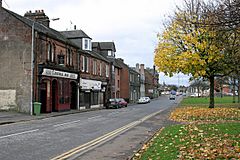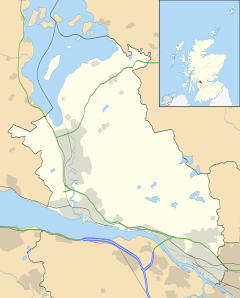Renton, West Dunbartonshire facts for kids
Quick facts for kids Renton
|
|
|---|---|
 Main Street in Renton |
|
| Population | 2,350 (2020) |
| OS grid reference | NS3878 |
| Civil parish |
|
| Council area | |
| Lieutenancy area | |
| Country | Scotland |
| Sovereign state | United Kingdom |
| Post town | DUMBARTON |
| Postcode district | G82 |
| Dialling code | 01389 |
| Police | Strathclyde |
| Fire | Strathclyde |
| Ambulance | Scottish |
| EU Parliament | Scotland |
| UK Parliament | |
| Scottish Parliament | |
Renton (which is An Reantan in Scottish Gaelic and The Renton in Scots) is a village in West Dunbartonshire, Scotland. It's located in the west Central Lowlands. In 2001, about 2,138 people lived there.
Renton is especially famous for its football team, Renton. This team was one of the first 11 clubs to start the Scottish Football League. They also won the Scottish Cup twice, in 1885 and 1888. Many great players came from Renton.
Contents
Discovering Renton's Past
Renton got its name from Cecilia Renton in 1762. She was related to the famous writer Tobias Smollett. The village was built with sandstone buildings.
Early industries like Dalquhurn Bleachworks (from 1715) and Cordale Printworks (from 1770) brought many new workers to the area. These factories helped the village grow.
Renton has always been a place where people cared a lot about their community. They often elected local leaders who wanted to make big changes.
The village is on the main road (A82) between Alexandria and Dumbarton. You can also get to Renton by train, as Renton railway station is on the line from Glasgow to Balloch. There's a footbridge over the River Leven that leads to the Strathleven Industrial Estate, which used to provide many jobs.
Did Robert the Bruce Live Here?
There's a story that the ruins of a house belonging to Robert the Bruce, a famous King of Scotland, might be buried in Renton. Some old records suggest he had a manor house or hunting lodge nearby.
However, experts are still trying to confirm this. It's thought that his house might have been a bit further south, closer to an area called Mains of Cardross. Finding old stone and mortar doesn't always tell us exactly when a building was made, as these materials were used for a very long time.
Renton Today
In recent years, Renton has seen many improvements, especially with new and better housing. The community is working to make the village an even better place to live.
Famous People from Renton
Many notable people have connections to Renton:
- Jack Ashurst, a footballer
- Robert the Bruce, King Of Scotland
- Jane Duncan, an author
- Andy Duncan, a footballer
- Sir Alex Ferguson: His grandfather and father were born in Renton. They worked in the shipyard in Dumbarton.
- Skeets Gallacher, a boxer
- James Allison Glen, a Canadian politician
- Andrew Hannah, a footballer
- Alex Jackson, a footballer
- James Kelly, a footballer
- Duncan McLaren, a Scottish politician
- John O'Hare, a footballer
- Tobias Smollett, a writer and surgeon
- William Wilson, an Australian politician
Sports in Renton
Renton has a proud history in sports, especially football!
Renton Football Club: World Champions!
In 1888, Renton F.C. became "Champions of the World." Back then, football was mostly played by Scottish and English teams. Renton won the Scottish Cup by beating Cambuslang F.C. 6-1.
Then, they played against the English Cup holders, West Bromwich Albion. Renton won 4-1 in front of 10,000 fans! They even beat "The Invincibles" of Preston North End. A sign saying "Champion of the World" was proudly displayed at their home ground, Tontine Park. Renton was ahead of its time, training hard for strength and stamina.
Quoiting: A Local Favorite
Quoiting (pronounced kite-ing) was another popular sport for men in the village. Players would throw heavy iron rings, called quoits, at a steel pin stuck in a clay bed. The quoits weighed between 8 and 12 pounds (about 4 to 5.5 kg). Renton teams were Scottish Champions in quoiting in 1949 and 1986. You can even see a photo of the 1949 winning team at Renton Railway Station!
Fun Things to Do in Renton
Renton has several places for fun and daily needs. There's a new mini-supermarket and a healthy living center. You can also find a bowling green.
Wylie Park, also known as Tontine Park, is a popular spot. It's used for football games most Saturdays and Sundays. It's also the home ground for the local youth football team, Renton Craigandro.
There's a youth club at the Autism and Aspergers Centre (which used to be a nursery). It meets every Wednesday. There are different times for younger kids (Primary 1 to 6) and older kids (1st, 2nd, and 3rd Years of high school).
See also
 In Spanish: Renton para niños
In Spanish: Renton para niños


